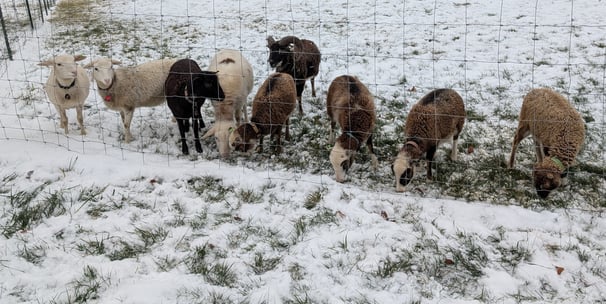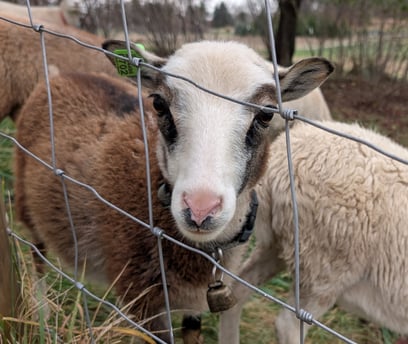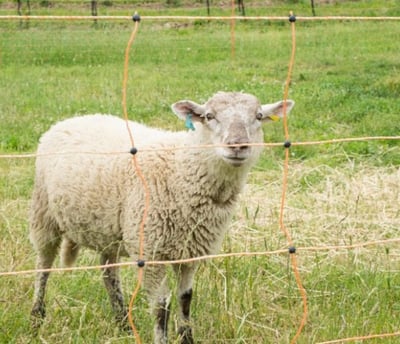Understanding & Handling Your Flock (Featuring Grain Training!)
Working effectively with sheep requires understanding their natural instincts. As prey animals, their primary motivations revolve around safety and staying with the flock. Handling them calmly and using their instincts (and a little bit of bribery!) makes management much easier and less stressful for everyone.


Sheep Behavior Basics
Flocking Instinct: This is their strongest trait. Sheep feel safe in a group. A single sheep separated from the flock will be highly stressed and difficult to handle. Always try to move them in groups.
Prey Animals: They are naturally wary and alert to perceived dangers. Sudden movements, loud noises, and unfamiliar objects or situations can cause them to panic or bolt.
Flight Zone: This is the imaginary "personal space" bubble around a sheep. When you enter it, the sheep will typically move away. The size varies based on how accustomed they are to people – tamer sheep have smaller flight zones.
Point of Balance: This is usually at the sheep's shoulder. If you stand behind it, the sheep will move forward. If you step in front of it, it will stop, back up, or turn. Learning to use this point allows you to guide sheep without chasing them.
Vision: Sheep have wide peripheral vision (almost 300 degrees) to watch for predators, but poor depth perception. They can be spooked by shadows, changes in ground surface, or moving into dark areas. They prefer to move towards lighter areas and can see movement well.
Follow the Leader: Sheep will generally follow other sheep. Getting one or two "leaders" to move often encourages the rest to follow.
Food Motivated: Sheep learn quickly where their food comes from, and they particularly love treats like grain. This is a powerful tool for training.
Low-Stress Handling Techniques
The goal is to move sheep calmly and efficiently, minimizing fear and stress.
Be Calm & Quiet: Move slowly and deliberately. Speak in a low, calm voice. Avoid yelling, running, or flapping your arms.
Use Pressure & Release: Work on the edge of their flight zone. Step towards them (applying pressure) to make them move, and step away (releasing pressure) to let them settle or stop.
Work with the Flock: Use their instinct to stay together. Guide the group, not individuals, whenever possible.
Avoid Dead Ends & Sharp Turns: Design pens and chutes so sheep can see a way forward and move smoothly. Solid sides can sometimes help keep them focused.
Be Patient: Rushing often leads to panic and makes the job harder and longer.


Patience and consistency are your best friends when handling and training sheep. By understanding their behavior and using tools like grain training wisely, you can build a positive relationship with your flock and make managing them a much more enjoyable experience.


Training with Grain: Your Secret Weapon
Teaching your sheep to associate you (or a specific call) with grain can make moving them between pastures, bringing them into the barn, or simply checking on them a breeze.
Why It Works: Grain is a high-value treat. Sheep are smart and quickly learn what brings this reward. It builds a positive association with your presence.
The Goal: To have your sheep willingly come towards you when you call or show them the grain bucket.
The Process:
Choose a Consistent "Call": Decide on a unique sound you only use for grain. This could be a specific word ("Sheeeep-eee!"), a phrase, a whistle, or simply the sound of shaking a grain bucket. Consistency is vital.
Start in a Contained Area: Begin your training sessions in a smaller pen or paddock where the sheep feel relatively secure and can't just run far away.
Show & Tell: Approach the sheep calmly. Use your "Call" and let them see and hear the grain bucket.
Offer the Reward (Be Patient): Initially, they will likely be wary. Make your "Call," put a small amount of grain in a trough or even a shallow pan on the ground, and step back. Let them come to it on their own time. The bravest ones will come first; others will follow their lead.
Repeat, Repeat, Repeat: Do this regularly, ideally once or twice a day (using only small amounts of grain!). They need consistent repetition to build the strong association: Call = Grain = Good Thing!
Build Trust: As they become bolder, gradually decrease the distance you step back. Eventually, many sheep (especially breeds like Katahdins) will eat from a bucket you hold, or even cautiously from your hand.
Generalize: Once they reliably come to your call in the small pen, start practicing from further away. Call them from one end of the paddock to the other. Then, try calling them through an open gate into the next paddock. This is where the real management benefit comes in!
Important Tips & Cautions:
Small Amounts: Use grain as a training tool, not a major food source (unless their nutritional stage requires it). Small amounts are usually sufficient to motivate them for training.
"Sheep Manners": Trained sheep can become very enthusiastic (pushy!). Be firm and safe. Don't let large sheep knock you or children over. You might teach them they only get the grain when you put it down, not when they mob you.
Use Troughs: When feeding a group, use long troughs or multiple feeders to spread them out and reduce competition and aggression.
Don't Rely Only on Grain: While invaluable, grain training doesn't replace good low-stress handling skills. Sometimes you'll need to move sheep when they don't want to go, and the bucket won't work.
Health First: Never overfeed grain, as it can cause serious digestive issues. Always ensure it's sheep-safe (no added copper).
